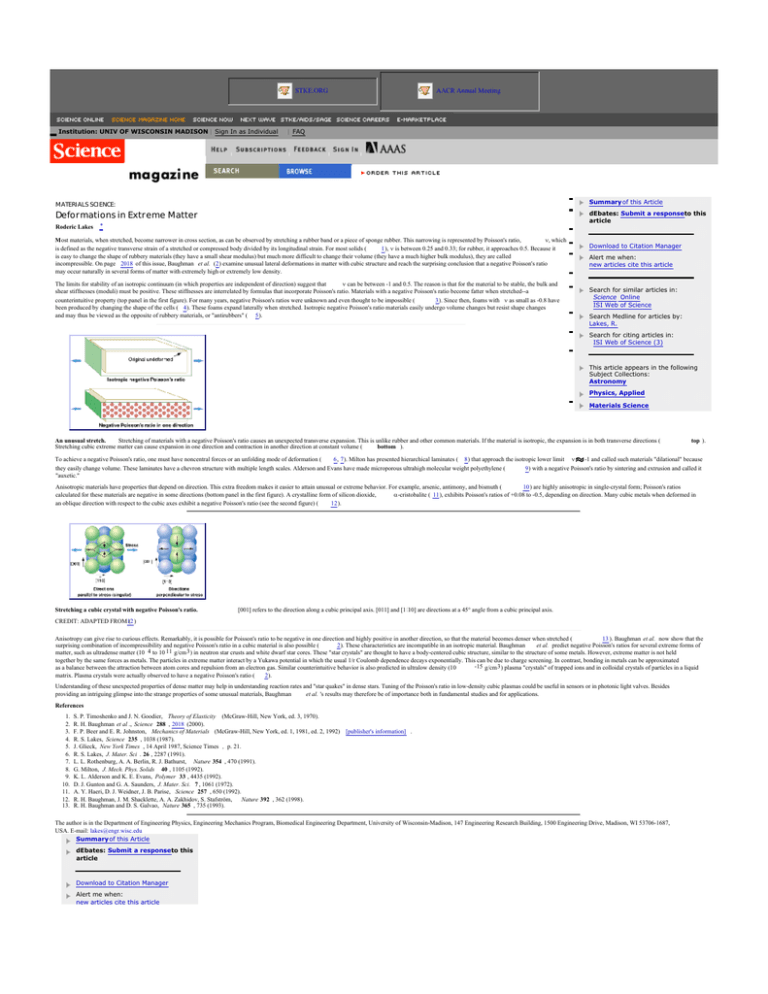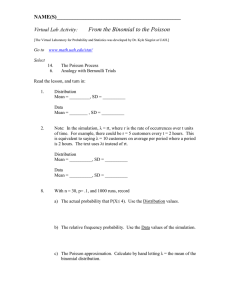
STKE.ORG
Institution: UNIV OF WISCONSIN MADISON | Sign In as Individual
AACR Annual Meeting
| FAQ
MATERIALS SCIENCE:
Summary of this Article
Deformations in Extreme Matter
dEbates: Submit a responseto this
article
Roderic Lakes
*
Most materials, when stretched, become narrower in cross section, as can be observed by stretching a rubber band or a piece of sponge rubber. This narrowing is represented by Poisson's ratio,
ν, which
is defined as the negative transverse strain of a stretched or compressed body divided by its longitudinal strain. For most solids (
1), ν is between 0.25 and 0.33; for rubber, it approaches 0.5. Because it
is easy to change the shape of rubbery materials (they have a small shear modulus) but much more difficult to change their volume (they have a much higher bulk modulus), they are called
incompressible. On page 2018 of this issue, Baughman et al. (2) examine unusual lateral deformations in matter with cubic structure and reach the surprising conclusion that a negative Poisson's ratio
may occur naturally in several forms of matter with extremely high or extremely low density.
The limits for stability of an isotropic continuum (in which properties are independent of direction) suggest that
ν can be between -1 and 0.5. The reason is that for the material to be stable, the bulk and
shear stiffnesses (moduli) must be positive. These stiffnesses are interrelated by formulas that incorporate Poisson's ratio. Materials with a negative Poisson's ratio become fatter when stretched--a
counterintuitive property (top panel in the first figure). For many years, negative Poisson's ratios were unknown and even thought to be impossible (
3). Since then, foams with ν as small as -0.8 have
been produced by changing the shape of the cells ( 4). These foams expand laterally when stretched. Isotropic negative Poisson's ratio materials easily undergo volume changes but resist shape changes
and may thus be viewed as the opposite of rubbery materials, or "antirubbers" ( 5).
Download to Citation Manager
Alert me when:
new articles cite this article
Search for similar articles in:
Science Online
ISI Web of Science
Search Medline for articles by:
Lakes, R.
Search for citing articles in:
ISI Web of Science (3)
This article appears in the following
Subject Collections:
Astronomy
Physics, Applied
Materials Science
An unusual stretch.
Stretching of materials with a negative Poisson's ratio causes an unexpected transverse expansion. This is unlike rubber and other common materials. If the material is isotropic, the expansion is in both transverse directions (
Stretching cubic extreme matter can cause expansion in one direction and contraction in another direction at constant volume (
bottom ).
top ).
-1 and called such materials "dilational" because
To achieve a negative Poisson's ratio, one must have noncentral forces or an unfolding mode of deformation (
6, 7). Milton has presented hierarchical laminates ( 8) that approach the isotropic lower limit ν
they easily change volume. These laminates have a chevron structure with multiple length scales. Alderson and Evans have made microporous ultrahigh molecular weight polyethylene (
9) with a negative Poisson's ratio by sintering and extrusion and called it
"auxetic."
Anisotropic materials have properties that depend on direction. This extra freedom makes it easier to attain unusual or extreme behavior. For example, arsenic, antimony, and bismuth (
10 ) are highly anisotropic in single-crystal form; Poisson's ratios
calculated for these materials are negative in some directions (bottom panel in the first figure). A crystalline form of silicon dioxide,
α-cristobalite ( 11 ), exhibits Poisson's ratios of +0.08 to -0.5, depending on direction. Many cubic metals when deformed in
an oblique direction with respect to the cubic axes exhibit a negative Poisson's ratio (see the second figure) (
12).
Stretching a cubic crystal with negative Poisson's ratio.
[001] refers to the direction along a cubic principal axis. [011] and [1¯10] are directions at a 45° angle from a cubic principal axis.
CREDIT: ADAPTED FROM12
( )
Anisotropy can give rise to curious effects. Remarkably, it is possible for Poisson's ratio to be negative in one direction and highly positive in another direction, so that the material becomes denser when stretched (
13 ). Baughman et al. now show that the
et al. predict negative Poisson's ratios for several extreme forms of
surprising combination of incompressibility and negative Poisson's ratio in a cubic material is also possible (
2). These characteristics are incompatible in an isotropic material. Baughman
matter, such as ultradense matter (10 4 to 10 11 g/cm 3 ) in neutron star crusts and white dwarf star cores. These "star crystals" are thought to have a body-centered cubic structure, similar to the structure of some metals. However, extreme matter is not held
together by the same forces as metals. The particles in extreme matter interact by a Yukawa potential in which the usual 1/r Coulomb dependence decays exponentially. This can be due to charge screening. In contrast, bonding in metals can be approximated
-15 g/cm 3 ) plasma "crystals" of trapped ions and in colloidal crystals of particles in a liquid
as a balance between the attraction between atom cores and repulsion from an electron gas. Similar counterintuitive behavior is also predicted in ultralow density (10
matrix. Plasma crystals were actually observed to have a negative Poisson's ratio (
2).
Understanding of these unexpected properties of dense matter may help in understanding reaction rates and "star quakes" in dense stars. Tuning of the Poisson's ratio in low-density cubic plasmas could be useful in sensors or in photonic light valves. Besides
providing an intriguing glimpse into the strange properties of some unusual materials, Baughman
et al. 's results may therefore be of importance both in fundamental studies and for applications.
References
1.
2.
3.
4.
5.
6.
7.
8.
9.
10.
11.
12.
13.
S. P. Timoshenko and J. N. Goodier, Theory of Elasticity (McGraw-Hill, New York, ed. 3, 1970).
R. H. Baughman et al ., Science 288 , 2018 (2000).
F. P. Beer and E. R. Johnston, Mechanics of Materials (McGraw-Hill, New York, ed. 1, 1981, ed. 2, 1992) [publisher's information] .
R. S. Lakes, Science 235 , 1038 (1987).
J. Glieck, New York Times , 14 April 1987, Science Times , p. 21.
R. S. Lakes, J. Mater. Sci . 26 , 2287 (1991).
L. L. Rothenburg, A. A. Berlin, R. J. Bathurst, Nature 354 , 470 (1991).
G. Milton, J. Mech. Phys. Solids 40 , 1105 (1992).
K. L. Alderson and K. E. Evans, Polymer 33 , 4435 (1992).
D. J. Gunton and G. A. Saunders, J. Mater. Sci. 7 , 1061 (1972).
A. Y. Haeri, D. J. Weidner, J. B. Parise, Science 257 , 650 (1992).
R. H. Baughman, J. M. Shacklette, A. A. Zakhidov, S. Stafström,
Nature 392 , 362 (1998).
R. H. Baughman and D. S. Galvao, Nature 365 , 735 (1993).
The author is in the Department of Engineering Physics, Engineering Mechanics Program, Biomedical Engineering Department, University of Wisconsin-Madison, 147 Engineering Research Building, 1500 Engineering Drive, Madison, WI 53706-1687,
USA. E-mail: lakes@engr.wisc.edu
Summary of this Article
dEbates: Submit a responseto this
article
Download to Citation Manager
Alert me when:
new articles cite this article
new articles cite this article
Search for similar articles in:
Science Online
ISI Web of Science
Search Medline for articles by:
Lakes, R.
Search for citing articles in:
ISI Web of Science (3)
This article appears in the following
Subject Collections:
Astronomy
Physics, Applied
Materials Science
Volume 288, Number 5473, Issue of 16 Jun 2000, pp. 1976-1977.
Copyright © 2000 by The American Association for the Advancement of Science. All rights reserved.
AAAS Member Only Site
STKE





